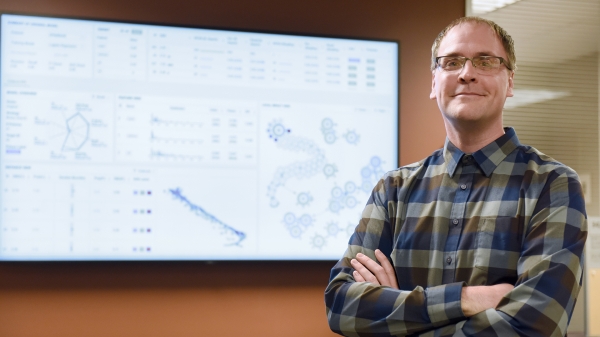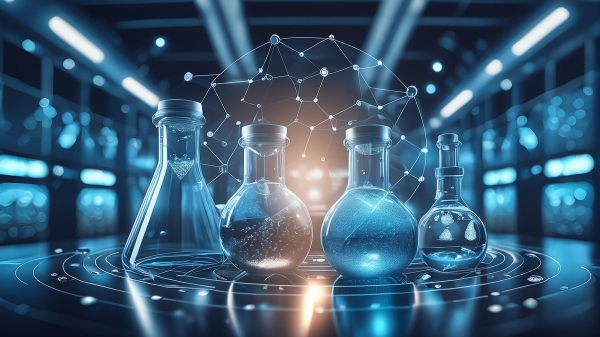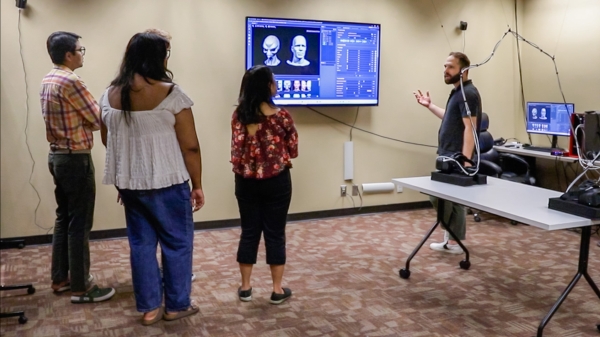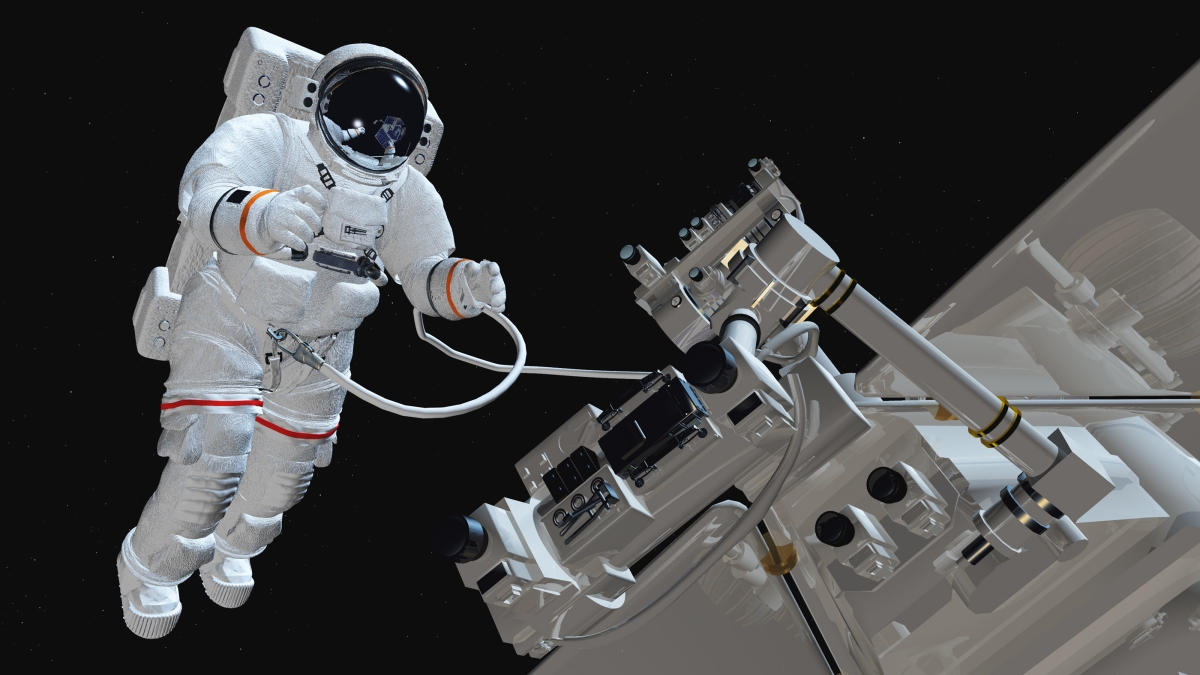You’d be hard-pressed to find a seasoned businessman or woman who hasn't sat through a mid-morning meeting, oblivious to the decisions being made or plans being hatched.
Often, that out-to-lunch incognizance exists because that person's mind is still kneading through a difficult problem left undone on his or her desk.
Such spacey discord — the occasional inability to completely disconnect ourselves from one chore to focus on the next — is something that happens to all of us, including those who actually go into space to perform various scientific and technical assignments.
That’s why NASA has commissioned Jeff LePine, a management professor at the W. P. Carey School of Business, to understand how astronauts aboard the International Space Station make transitions from task to task, particularly when they’re going from individual duties to team responsibilities, or from very important, engaging activities to those that are downright mundane.
LePine has teamed with management colleagues Ned Wellman, an assistant professor at business school, and Daniel Newton, a doctoral student, to conduct a three-year study for the U.S. space agency. In the end, the team hopes to walk away with a list of countermeasures they can provide mission planners and system developers to help ISS crews switch gears more effectively and avoid the risks of distraction.
About-face floundering
Why is task transition so important to NASA? Because the space station is a research facility designed to perform world-class science and research that only a microgravity environment can provide.
So, station crews spend their days working on science experiments that require their own input, as well as monitoring those that are controlled from the ground. But, they also have to maintain the facility, so flight crews are constantly checking support systems, cleaning filters, updating computers and handling basic housekeeping — tasks that often must be conducted in accordance with a schedule — not necessarily the astronaut’s preference.
“It’s a mix of the transcendently magical and the deeply prosaic,” said astronaut Marsha Ivins, who has completed five missions for NASA and spent 55 days off our planet.
And, while the maintenance chores may not be as engaging as the scientific experiments, they’re vitally important to crew survival. An error could bring harm or death. Likewise, working individually requires different demands and thinking than teamwork.
What’s more, performing the maintenance tasks may require astronauts to go from long periods of working autonomously to some interdependent task, which calls for different skills and ways of operating. According to a report produced by NASA, “such shifts are believed to create risks with regard to crew performance.”
“When you start working together with other people, you eventually get into this routine way of doing things,” LePine explained. That is, teams working together on interdependent tasks develop norms and shared processes and ways of thinking that are specific to their particular interdependent task. “This is referred to as routine performance,” he adds.
Along with routine, there’s engagement. LePine’s previous research has shown that individuals can become highly invested in their work physically, cognitively and emotionally. Engagement can vary with the completeness, complexity or consequentiality of the tasks. So, for example, LePine sees potential transition issues with a switch from a team task that is important and complex but incomplete to an individual task that is, perhaps, less important but still complex.
“The more complex, less complete and more consequential a prior task is, the more likely you are to have residual engagement that interferes with the transition to the subsequent task,” he said.
In his research, LePine is going to try to decouple these three facets of tasks to see which most impact residual engagement, which he likens to an after-image.
“When you look at something bright and then you look away, you have this sort of after-image that is in your brain or in your eyes,” he said. “It’s kind of the same thing with engagement. If you are working on something really intensely and then you have to turn your attention to something else, the first task stays with you.”
LePine and his colleagues will explore ways to mitigate residual engagement. This exploration will take place with lab-based experiments at the W. P. Carey School as well as four missions involving astronauts working in NASA’s Human Exploration Research Analog (HERA), formerly known as the Deep Space Habitat.
HERA is a three-story habitat designed to help scientists examine risks and gaps associated with human performance during spaceflight. Historically, the habitat was used for engineering systems demonstrations. Now, NASA uses it to simulate the isolation, confinement and remote conditions astronauts endure during space missions.
The findings from this research will culminate in three planned missions aboard the ISS in 2017-2018. These missions will last six months. During this time LePine and his team will collect additional data and begin to examine interventions designed to improve effectiveness during task transitions.
Playing with fire
Back at the W. P. Carey School, the lab research will have students playing with fire, literally.
“We’re running undergraduates through an experiment where the students are engaged in a firefighting task,” LePine said. “Each of the students has a different role: there is a fire chief, the person who delivers water to the different firefighters, the primary firefighter and a scout firefighter, who is sort of a first responder.”
Playing their roles, each student sits at a networked computer fighting a simulated forest fire. To manipulate the consequentiality of the fire, LePine and team may have some students fighting in brush and woodlands, while others are on the outskirts of suburbia, right next to people’s homes. The researchers also manipulate the complexity and completeness of the students’ fire fight.
Half-way through, the researchers stop the firefighting altogether.
“We say, ‘OK, now your job is to do some maintenance on your firetrucks,’ and then we give each of the students some Legos. As individuals, they have to put this Lego thing together. Then we cut them off and then put them back to the team task to finish fighting the fire,” LePine said.
Lessons learned from the lab simulations will be put to more vigorous testing in the HERA habitat. From there, the researchers hope to develop protocols to help ensure that residual engagement in task switching impacts productivity as little as possible.
Planning for disruption
Already, LePine and his team are thinking about possible ways to make task shifting less distracting.
“Given that astronauts don’t have much control over their schedules we’re looking for ways to plan for a transition,” he said.
So, for instance, if an astronaut is working on an experiment, part of the project planning could include a recommendation for how to put things away when called into another set of duties. Or, when transitioning to a team task, the researchers will examine whether pre-briefing — catching everyone up on the project — and de-briefing — such as a round-robin discussion where each player talks about things that went well and how things could go better — might be a way to help people ease into the next round of work.
The team also will look at checklists as a way to get people “thinking about the new task as opposed to the old task that they were doing,” LePine said.
Ultimately, he sees this work being of value in space and on earth.
“Most people’s jobs today are multifaceted, particularly professional jobs where people are working on a bunch of different teams and projects throughout the day,” he said. “People are always transitioning between different things, and we know very little about the factors that could enhance effectiveness during those transitions.”
And, it matters. “It’s during transitions when a lot of mistakes take place.”
Written by Betsy Loeff, W. P. Carey School of Business.
More Science and technology

ASU computing school director honored with prestigious award
Today, in an increasingly complex world, lawmakers and leaders must make big decisions, and they must often do so very quickly.Because of this, data visualization is an increasingly important…

Discovering new materials using AI and machine learning
The United States, in recent years, has been struggling with a supply shortage of critical materials needed for advanced materials discovery and manufacturing. Widespread delays have impacted sectors…

ASU researchers experiment with breakthrough tech exploring human communication, perception
Digital manipulation of video images, whether for blockbuster films or malicious intent, also known as deepfakes, has become commonplace. But the ability to create realistic-looking and -…
